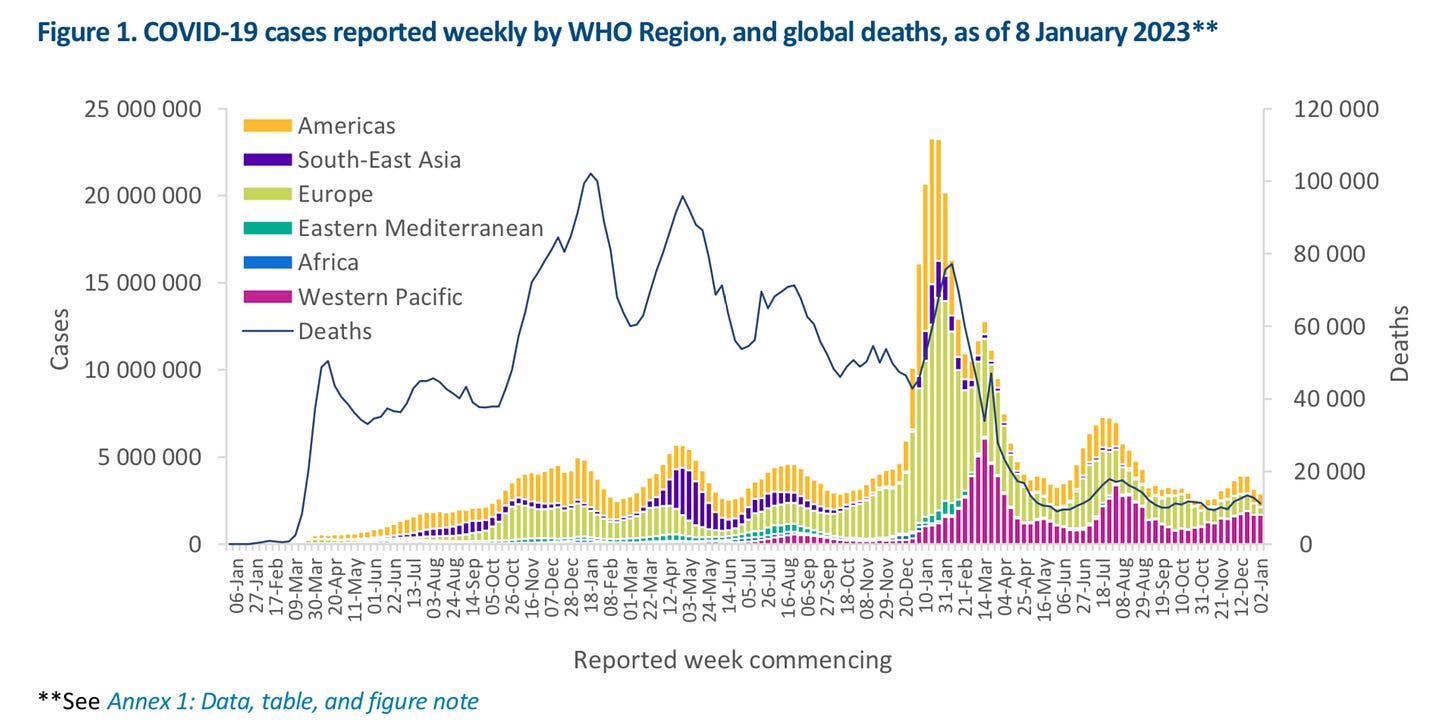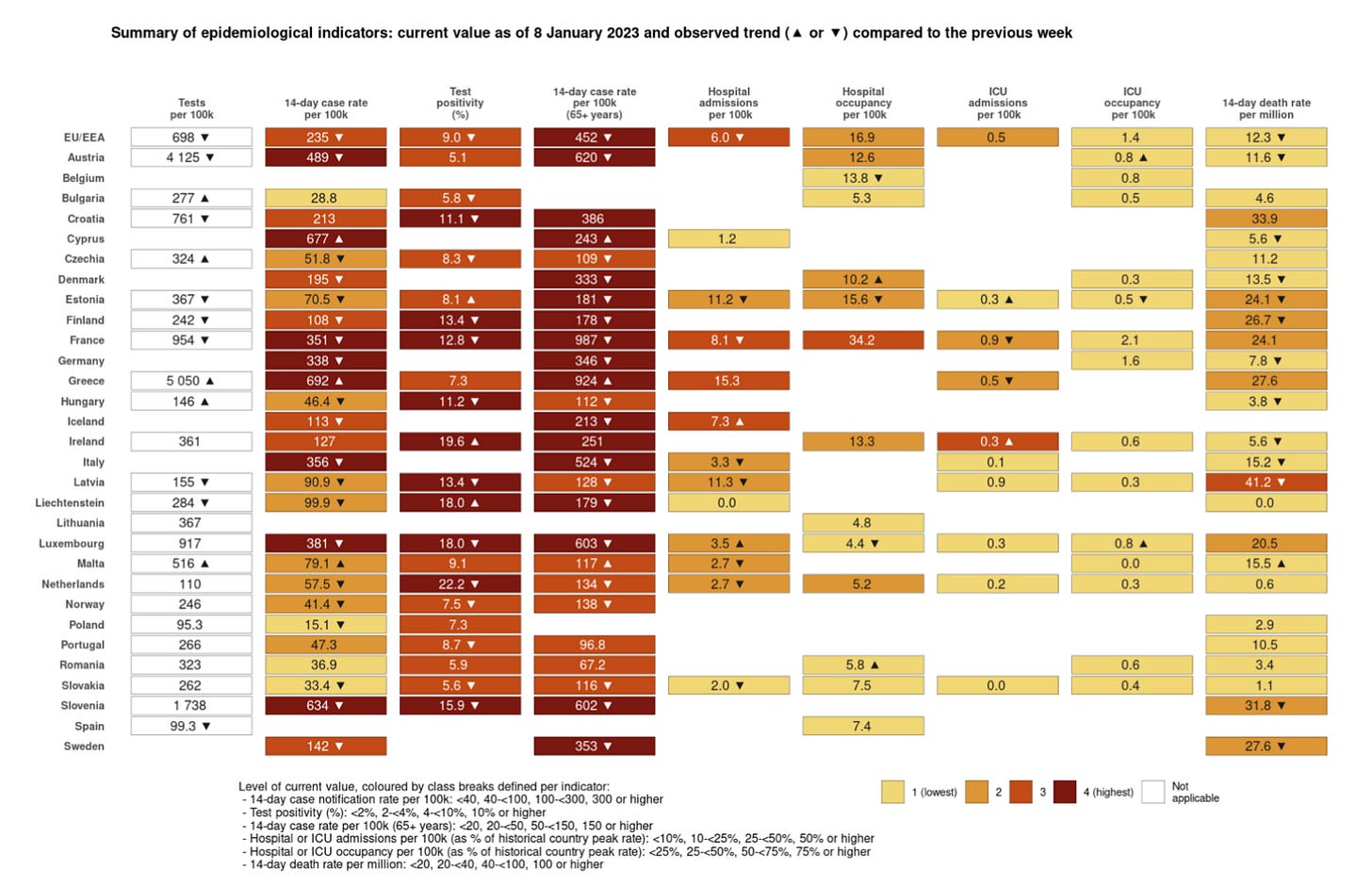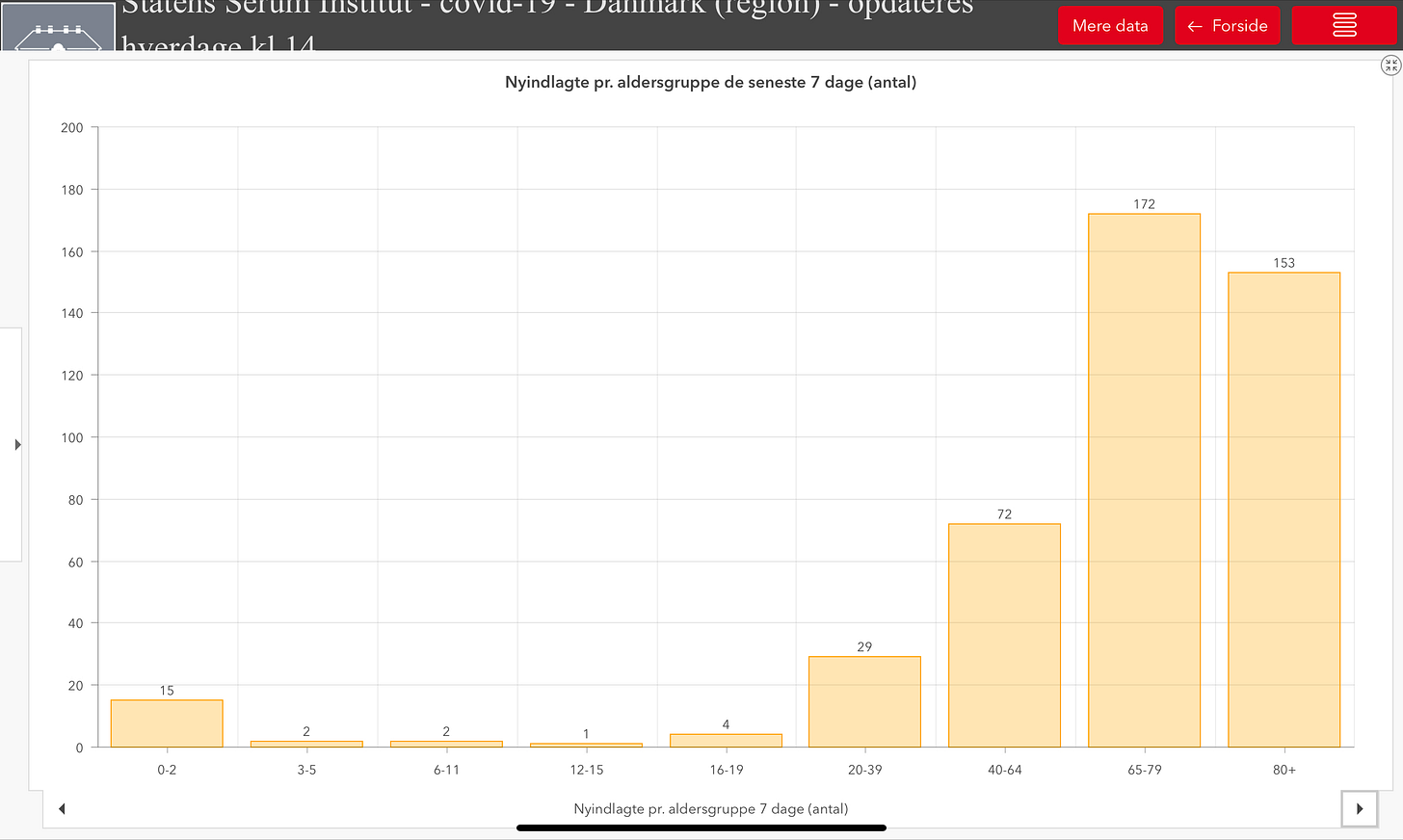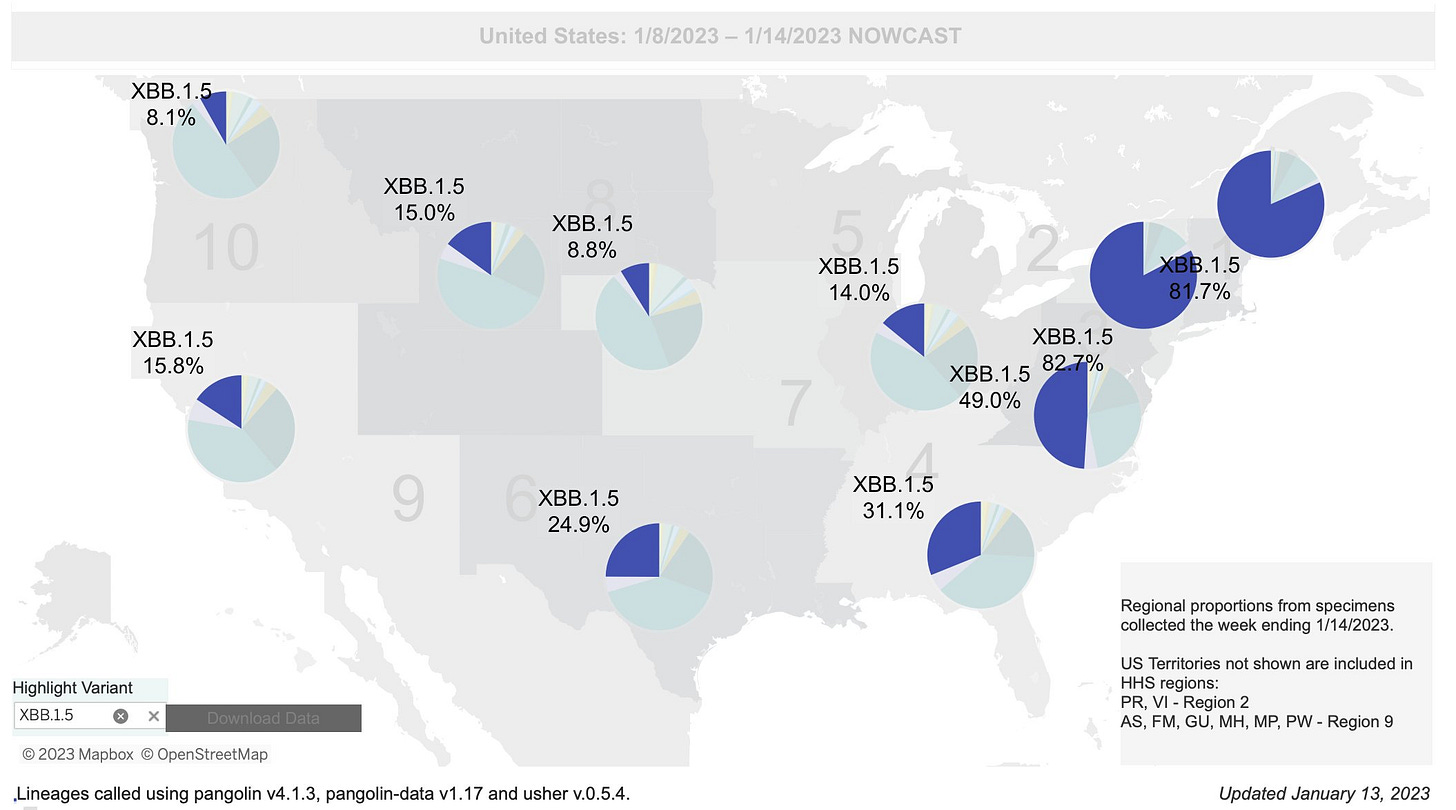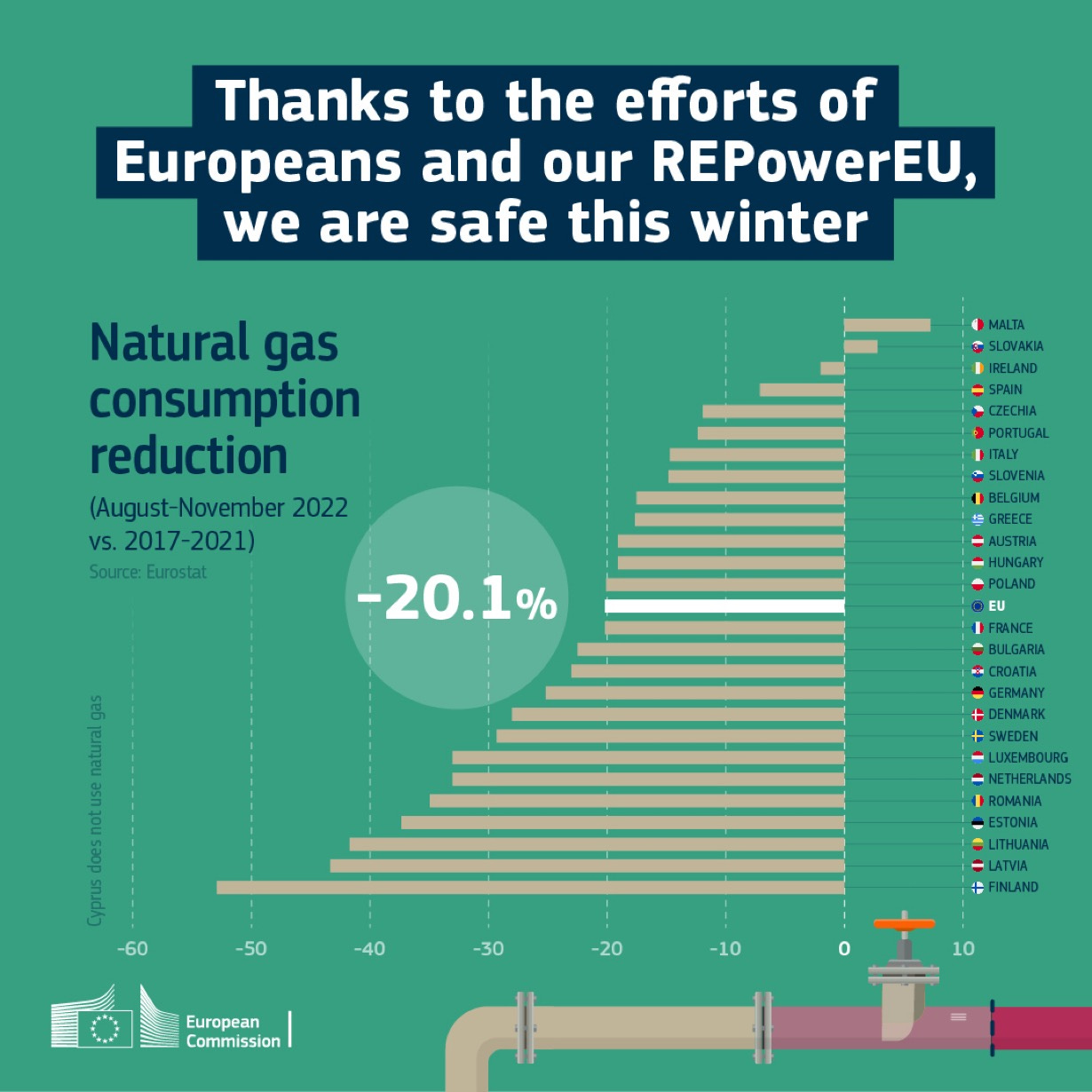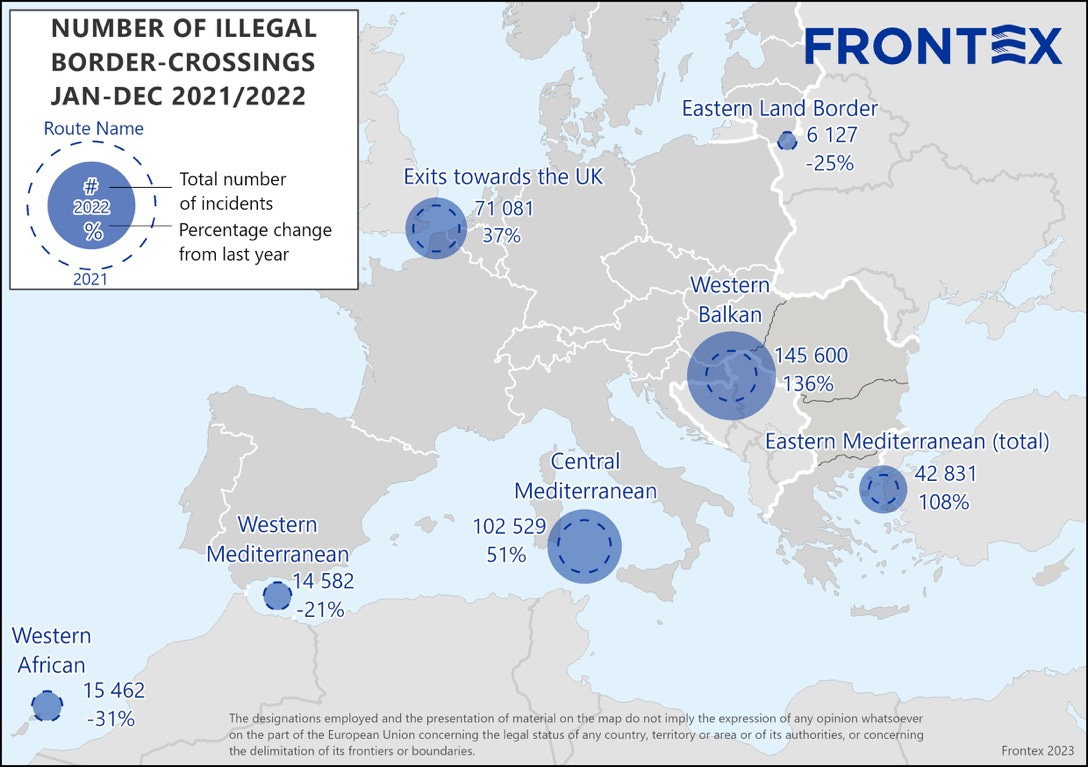Monday Morning News & Notes
Global pandemic picture uncertain. Danish healthcare system struggling.
🦠Pandemic🦠
🦠 🌏
The global pandemic picture remains uncertain, according to the latest weekly snapshot from the World Health Organization. It says the first week of the year saw nearly 2.9 million new infections and over 11,000 more deaths. Week over week, that is a decline of 9% and 12% respectively. However, over a 28 day period there were more than 13.9 million coronavirus cases and over 49,000 lost lives. Compared to the previous 28 day period, that is a 10% and 22% increase.
The WHO says the global pandemic picture remains very clouded.
“These trends need to be interpreted with caution considering the reduction in testing and delays in reporting in many countries during the year-end holiday season. Therefore, data presented in this report, especially for the most recent weeks, are incomplete and the decreasing trends should be interpreted in that context.”
With that in mind, infection activity remained stable or declined across all six WHO regions. The European Region saw the biggest drop (-36%), followed by the South-East Asia Region (-27%), the African Region (-23%), the Region of the Americas (-7%), the Eastern Mediterranean Region (-1%), and the Western Pacific Region (+1%).
Four regions saw pandemic deaths either decline or more or less stay the same. The African Region had by far the biggest decline (-53%), followed by the European Region (-34%), the South-East Asia Region (-19%), and the Region of the Americas (-3%). But in the Eastern Mediterranean Region fatalities rose (+31%), as they also did in the Western Pacific Region (+5%).
Looking at it by country, Japan continued to register the most new weekly infections with 1,070,496 (+13%), followed by the United States with 462,944 (+17%), and South Korea with 403,800 (-12%).
The U.S. began the new year much the way it has spent virtually the entire pandemic by again recording the highest number of weekly COVID deaths, with another 2,695 American lives lost (+8%). It was followed by Japan (2149 new deaths; +11%), Brazil (926 new deaths; -17%), and China (722 new deaths; +11%).
On the variant front, the WHO has six strains topping its concern list. They are the BQ.1 variant, which accounted for 53.4% of all sequenced positive tests in the second last week of 2022. BA.5 and several of its sub-variants accounted for 9.7%. BA.2.75 made up 8.1%. While the XBB variants accounted for 4.6%.
🇪🇺🦠
In contrast to the worsening pandemic picture in the weeks leading up to the Christmas holidays, the European Centre for Disease Prevention and Control says 2023 is starting out on a much better note. It says infection numbers across Europe were falling while hospitalizations and deaths were either stable or in decline.
But it cautioned people should take, especially infection numbers, with a big grain of salt.
“Data may still be affected by a combination of reduced testing, delayed reporting and changes in healthcare-seeking behaviour during the end of year holidays, which makes interpretation more challenging.”
At the country level, three European states reported increasing infection numbers. Seven out of the 21 countries reporting hospital admission data with either general or intensive care admissions rising. One country registered an increasing number of pandemic fatalities.
The ECDC cautions that despite a somewhat rosier picture for COVID hospitalizations, there is still “considerable” infection-related activity in hospitals across the European Union and the greater European Economic Area. It adds that it may take some more time to see the results of holiday-related infection spread.
Over the next two weeks, the ECDC is forecasting that infection numbers, hospitalizations, and coronavirus deaths will all decrease.
To date, 54.7% of the total European population has one COVID vaccine booster dose. For seniors over the age of 60 uptake rises to 84.8%. And 34.4% of seniors have a 2nd booster dose.
Just ten countries are testing and sequencing in numbers large enough to be able to provide reliable data on variant activity. Of those, BQ.1 was the dominant strain accounting for 51.4% of sequenced positive tests. BA.5 is still hanging in there with 24.2%. BA.2.75 has increased by 15.5%. Last but not least, XBB came back in 5% of cases.
-
The overall risk for the general population is low. For seniors, vulnerable populations, and the unvaccinated the risk is moderate to high. This is a summary of the latest XBB.1.5 variant risk assessment from the European Centre for Disease Prevention and Control.
That said, the ECDC emphasizes that there is still a lot we don’t know about this variant, and that the risk assessment may change in the weeks ahead as those knowledge gaps are filled.
The agency’s mathematical modeling is forecasting that the XBB.1.5 variant will likely become the dominant strain in Europe, but not for a few months yet.
While the variant is one of the most immune evasive coronavirus strains we have seen yet, and definitely more contagious, the jury is still out on whether it causes more severe infections. The ECDC is careful to note that there are “currently no signals” that the variant causes anymore infection severity than any other Omicron sub-variant. The agency says in the United States XBB.1.5 is spreading 12% faster than any other coronavirus strain.
ECDC Director Andrea Ammon:
“The XBB1.5 sub-lineage is currently present only at very low levels in the EU/EEA but may become dominant in the EU/EEA in the next few months. In light of this, ECDC recommends carrying out appropriate testing and sequencing, increasing COVID vaccination uptake, and reinforcing infection prevention, and control measures. Non-pharmaceutical interventions such as staying home when ill, teleworking, good ventilation of indoor spaces, and appropriate use of face masks should also be considered.”
XBB.1.5 is an XBB sub-variant, which evolved from two earlier Omicron strains, with a few additional mutations thrown in for good measure.
🇩🇰
The Statens Serum Institute doesn’t provide COVID updates over the weekend. It will table three days worth of infection data later today.
-
An extraordinary effort is being made to get the Danish healthcare system back on track. The Ministry of the Interior and Health has carried out a thorough inspection of Denmark’s hospital system and doesn’t like what it has found. Despite major efforts and a ton of money to tackle long waiting lists and other procedural delays incurred by years of dealing with the pandemic and last years nurses strike, the ministry says no appreciable progress has been made. Long wait times persist; compliance has dropped for the right to timely treatment; staffing shortages continue to be a problem, and productivity across the hospital system has dropped.
Minister of the Interior and Health Sophie Løhde:
“After more than two years with a large waiting list hump in our healthcare system, it has been important for me to have a thorough inspection of the hospital system and take stock. The figures show that there are very deep challenges and that there has been no real settlement of the treatment backlog. It is worse than expected, and the review shows that we need to implement a wide range of initiatives.”
Løhde warns that things are likely to get worse before they get better.
“Unfortunately, we are looking into a period when patients will experience long waiting times before things start to go the right way again. Therefore, we also have to be completely honest with the Danes that this cannot be solved overnight.”
The average waiting time for treatment was 46 days, and the ministry says those are going to increase further and will continue to be a problem “beyond 2023.”
Løhde says extraordinary efforts to address healthcare woes are underway.
“Negotiations with the Danish Regions on a two-year emergency plan for the healthcare system have begun. It is crucial that we create a sustainable plan that can help to reverse this development, so that patients can have a waiting time that we are used to. We must set realistic objectives for how the activity will come about, and the concrete initiatives must be realizable.”
A commission will also be set up to examine every aspect of healthcare structure. The government will also strike a ‘cross-cutting national prioritization council to ensure maximum benefit for each healthcare dollar spent. Tripartite negotiations around a healthcare framework that begins with a one-billion kroner (about $194 million Cdn) investment this year before increasing to three-billion kroner (about $974 million Cdn) next year.
-
The Danish National Health Board is reminding vulnerable seniors that if they get a COVID infection there are several pill treatments that will help, if they are administered in time. The health board for those 80 years old and older, especially those with underlying health conditions, they are at the highest risk of a severe coronavirus infection. A COVID treatment pill could make all the difference, but timing is crucial as the treatment must begin within five days of coronavirus symptoms.
The health authority is advising vulnerable populations to keep a number of self-testing kits on hand. The faster you know you are infected, the quicker you can act.
Senior Doctor Kirstine Moll Harboe:
“If the test is positive, or the suspicion of being infected is very high, for example, if the rest of the family has COVID, then call your doctor right away. Then your doctor can assess whether you are in the target group to get the tablet treatment.”
The Doctor can also assess a person’s medical history and any medications being taken to determine if that poses any issues with getting a COVID pill treatment.
“The tablet treatment is effective and can provide a milder course of the disease and reduce the risk of you becoming so ill that you have to be hospitalized. But you have to be quick to get an effect from the treatment, because you have to start taking the tablets no later than five days after you feel the first symptoms.”
The health board notes that COVID treatment pills, like Paxlovid, can be prescribed over the phone so there is no need to physically go see a doctor or get to a hospital.
-
Over the last seven days, the infection trend has continued with the highest number of new cases in the 40 to 64 year old age group. Compared to the numbers from a week ago, there has been quite a drop across the board.
-
Seniors 65 years old and older continue to bear the brunt of COVID-related hospitalizations, with 72% of all admissions over the last week. If you include the 40 to 64 year old age group, the percentage jumps to 88% of all admissions.
-
Women in their mid-40s made up a majority of those suffering from long-COVID according to a new Danish study. The study from Aarhus University and Defactum, a research and consulting agency, found that of the 448 patients struggling with long-COVID who participated in the study, three out of every four patients were women. The women were, on average, 47 years old with a bachelors or masters education. Most of them were struggling with fatigue and brain fog. About half were on sick leave from their jobs.
Study lead and Senior Researcher and Occupational Therapist Lisa Gregersen Østergaard spoke to Ritzau:
“We don't know why that group is so dominant. They had typically been healthy with a balanced and active family and work life until they were infected with COVID.”
Between five to ten percent of people who get a coronavirus infection suffer symptoms long after recovering. For some long-COVID is so bad they have to seek help at special clinics.
🇫🇮
The Finnish Institute for Health provides a once-a-week COVID update on Thursdays.
-
More than 7,300 lives were saved. That is the conclusion of an analysis done by the Finnish Institute for Health on the impact that COVID vaccines have had since vaccinations began in December of 2020. In addition, it found that vaccines likely played a role in preventing more than a thousand other deaths where COVID could have been a contributing factor.
The institute says vaccines played a huge role in preventing COVID deaths, especially among vulnerable seniors 70 years old and older. But they also saved some lives among younger age groups as well.
Statistician Ulrike Baum:
“According to the study, there were more than three times more deaths prevented than there were actual COVID deaths, which were 1,753. Vaccinations have had a significant effect in preventing severe coronavirus infections. Without vaccinations, there would have been significantly more severe outcomes.”
The institute estimates that administering the first booster dose saved around 1,300 lives. Those would be almost entirely among vulnerable seniors and those in high-risk groups.
Doctor Eero Poukka:
“In working-age people outside risk groups, vaccinations according to the current recommendations significantly reduce severe infections. In people under 60 who received two or three doses outside of the identified risk groups, only five deaths due to COVID were found during the follow-up period. The number is low when compared to, for example, twice-vaccinated 70 to 79-year-olds, where there were 112 pandemic deaths.”
Poukka says the study’s findings provide a lot of food for thought.
“In order to reduce the number of COVID deaths in Finland in the future, vaccinations should be targeted at seniors and other high-risk groups.”
🇸🇪
The Swedish Public Health Agency updates its pandemic statistics once a week every Thursday.
-
The risk of a severe COVID infection ending in death is higher among people who suffer from dementia, according to a new study from the largest medical university in Europe. The Karolinska Institute in Stockholm included about 5,000 people in its study, all COVID patients in hospitals in Stockholm, which showed coronavirus mortality was almost 70% higher among the approximately 800 people in the study group who had dementia. The mortality rate was even higher among patients with dementia who were also taking antipsychotic drugs, but the study says it wasn’t possible to prove any causal connection.
Geriatrics Professor Dorota Religa told Sveriges Radio that the study has provided important knowledge for how to treat infected patients with dementia and for communication with their families and guardians.
-
Sweden must constantly be prepared for new COVID variants to evolve and spread. That is according to Sahlgrenska University Hospital Chief Physician Magnus Gisslén. He is particularly concerned, right now, with the Omicron XBB.1.5 variant that is spreading around the globe. But its important to also be aware that, as has been the case for the entire pandemic, another new variant will eventually emerge and take over from XBB.1.5
🇩🇪
Germany’s Robert Koch Institute updates COVID numbers daily from Monday to Friday.
-
Germany is ending a mask mandate on all national train routes. Health Minister Karl Lauterbach made the announcement at a press conference on Friday. The mandate was due to expire on April 7, but will now be lifted as of February 2. It is one of the last national COVID restrictions in Germany.
“The population has built up a high degree of immunity, and the experts no longer believe that we will be hit by increased infection to a serious degree over the winter.”
It is important to note that COVID restrictions, what are left of them, may differ between each of Germany’s 16 states.
🇨🇳
On Saturday, China reported 59,938 coronavirus deaths in the span of just over a month from December 8, 2022 to January 12 this year. According to Agency France Presse, the head of the Chinese Bureau of Medical Administration under the National Health Commission, Jiao Yahui, says 5,503 deaths were directly due to a COVID infection, while the other 54,435 fatalities, a coronavirus infection, was a contributing factor.
The figure refers only to deaths recorded at medical facilities, with the total death toll likely to be higher.
China has been accused of vastly underreporting its pandemic statistics, including COVID deaths. Just last Wednesday, Chinese health officials said dwelling on exact pandemic numbers was “not necessary.”
The pandemic situation in China has exploded after authorities abandoned its severe zero-COVID strategy in the face of unprecedented public demonstrations. As one sign of Beijing’s iron fist, it was reported over the weekend that people who took part in those protests were being quietly rounded up.
One immediate question is, if Chinese authorities authorized the revealing of almost 60,000 pandemic deaths, how big is the real number?
🇯🇵
While China gets a lot of COVID headlines, the situation in Japan is brutal. The country is seeing an infection wave that is vying to be its largest ever, while pandemic deaths have never been higher. It has lost over 400 lives in each of the last four days alone.
🇺🇸
While everyone keeps a nervous eye on the XBB.1.5 variant, there may be some hopeful news out of the United States. The U.S. Centre for Disease Control says COVID hospitalizations in the American northeast, where the variant accounts for around 80% of cases, have plateaued. While there are still important questions needing answers, this might be a good indicator the variant does not cause more severe infections.
Nationally, XBB.1.5 accounts for 43% of all new infections in the States, up from 30% the week prior.
⚡️Energy Crisis⚡️
🇪🇺
The European Commission is thumbing its nose at Russia and its efforts to try and freeze Europe into submission by weaponizing its energy exports. The commission says Europe now has enough energy “to be safe this winter.”
It credits Europeans for making a major effort to conserve energy, reducing the strain on power grids across Europe, for helping to weather the energy crisis. Collectively, natural gas use was reduced by 20% across the EU. That exceeds the 15% reduction target set by European authorities. Of course, record breaking warm temperatures also played a major role in reducing gas consumption.
While the EU Commission essentially signals what it says is an end to the energy crisis, we are not out of the woods yet. If Europe were to suddenly go into a deep freeze before spring arrives then it could pose a serious challenge as heating demands would once again soar.
🇸🇪
The energy crisis keeps pushing inflation higher in Sweden. Inflation rose to 10.2% in December, an increase from November’s 9.5%. The increase is higher than experts had forecast. Soaring energy prices in December are getting the blame.
🇺🇦/ 🇷🇺 War
🇳🇴/ 🇷🇺
A former soldier with the Russian-backed Wagner militia, which is heavily involved in the fighting in Ukraine, made a dash across the Russian border into Norway over the weekend. Norwegian police arrested the man and he is now claiming asylum. His Norwegian lawyer, Jens Bernhard Herstad, has identified his client as Andrej Medvedev, a Wagner group commander. Reports also indicate Medvedev is willing to testify against Wagner Group leader Yevgeny Prigozhin for war crimes.
🇫🇮/ 🇩🇪 🇵🇱 🇺🇦
Tanks, or no tanks. Despite claims from Poland it will deliver ten or twelve highly sought-after Leopard tanks to Ukraine, Germany says it has not received an official request to do so.
Acting Finnish Defense Minister Mikko Savola says having Germany onboard is crucial to getting Leopard tanks to Ukraine. Savola says countries exporting Leopard tanks need a re-export permit from Germany to move them from one country to another. Also, he adds, that the tanks are weapons systems in need of maintenance and repair. Savola says the German defense industry is crucial to getting replacement parts and equipment. So an international coalition is needed to facilitate equipping Ukrainians with the tanks.
As for Finland donating some of its own Leopard tanks…
“Aid to Ukraine is evaluated together with the Defense Forces, without weakening Finland's own defense capability. We support Ukraine with our partners. Working together, we are stronger.”
Today Polish Prime Minister Mateusz Morawiecki will discuss getting Ukraine Leopard tanks directly with German Chancellor Olaf Scholz in Berlin.
🇬🇧/ 🇺🇦
On Saturday, British Prime Minister Rishi Sunak spoke to Ukrainian President Volodymyr Zelensky and confirmed that the United Kingdom would supply Ukraine with Challenger 2 tanks along with additional artillery systems.
The BBC is reporting it would likely be about a dozen of the tanks headed to Ukraine.
The Challenger 2 tanks are about 20 years old but would still be the most modern tank in the Ukrainian arsenal once they arrive.
The Prime Minister’s office confirmed that artillery systems to also be donated will be the AS90 self-propelled guns. In all, 30 of the artillery platforms will be sent to Ukraine. Downing Street says training will also begin so that Ukrainian soldiers can use the artillery pieces effectively.
Further:
“UK defense and security officials believe a window has opened up where Russia is on the backfoot due to resupply issues and plummeting morale. The PM is therefore encouraging allies to deploy their planned support for 2023 ASAP to have maximum impact.”
NATO/ 🇺🇦
Heavy weapons are coming to Ukraine and soon. That was the message on Sunday from NATO Secretary General Jens Stoltenberg. He said Ukraine can expect more heavy weapons deliveries from western countries. Ukraine has long pushed for access to more modern heavy weapons but they have been slow in coming as western nations try to walk a tightrope in supporting Ukraine but not getting drawn into the war itself.
🇹🇷/ 🇸🇪
The game of hardball continues from Turkey. Over the weekend, Turkish officials said the country was “not in a position” to ratify Sweden’s NATO membership. The Turkish government is insisting that Sweden has not fulfilled its commitments in a trilateral deal made in June. This boils down to Turkey trying to thwart Swedish rule of law as Sweden’s highest court has vetoed several extradition requests made by Turkey. One in particular, exiled journalist Bülent Keneş, is a person Turkish President Tayyip Erdoğan is desperate to get his hands on. Erdoğan has accused the journalist of being a member of the Gulen network he has blamed for being behind a failed coup attempt in 2016.
Sweden and Finland need all 30 NATO member countries to ratify their membership applications in order to join the military alliance. 28 nations have quickly ratified the ascension accords, with only Hungary and Turkey dragging their heels. Two countries who are heavily leaning into autocratic regimes.
🇸🇪/ 🇹🇷
Leverage can go both ways. While Turkey plays hardball with Sweden’s NATO application, Sweden is looking to the United States as a possible avenue to get Turkey to see reason. Turkey has long coveted getting American F-16 fighter jets and American authorities appear poised to possibly play ball.
Director of the Institute for Turkish Studies at Stockholm University Paul Levin spoke to Sveriges Radio to say this provides Sweden with an opportunity.
“This particular sale of combat aircraft, the F16, is something that Turkey has long wanted to get, and it has always figured as a possible carrot that the United States could provide.”
The United States has already ratified Sweden and Finkand’s NATO applications and has been a vocal supporter of the two Nordic countries joining the alliance. Levin says the States could potentially apply enough pressure on this front to tip the balance.
NATO/ 🇷🇺 🇺🇦
Several NATO surveillance aircraft are being transferred from Germany to Romania putting them in much closer proximity to the war in Ukraine. In a statement, NATO said that the Airborne Warning and Control System (AWACS) surveillance planes will arrive in Bucharest on Tuesday (tomorrow) to “support the alliance in the region and monitor Russian military activity.”
🇪🇺
Europe continues to see a migrant crisis. The EU border agency, Frontex, reports that 2022 saw the highest number of irregular border crossings since 2016. With around 330,000 migrant crossings into Europe last year, that is a year-over year increase of 64%.
The agency says the number of Syrian refugees (94,000) roughly doubled last year. Syrians, Afghans, and Tunisians, all accounted for 47% of detected crossings. Women accounted for fewer than one out of every ten migrants, while the number of minors fell to 9%.
The other big pressure point was Ukraine, with almost 13 million Ukrainian refugees crossing into Europe fleeing the Russian invasion.
45% of all ‘irregular’ crossings last year came via the Western Balkans.
🇩🇰/ 🇷🇺
Danish banks have been the subject of several cyber attacks. Last week, the IT systems of several banks were targeted in a DDOS attack. That is where hackers try to overwhelm a server by sending millions of simultaneous requests. Then over the weekend, Jyske Bank, Sydbank, and Djursland Bank were among the banks that were hit again. This time, online banking services were knocked out for most of Saturday.
Bankdata Communications Consultant Jens Refsgaaard spoke to bt.dk:
We have experienced an attack on our banks' websites. At the same time, we had a problem with our mobile and online banking earlier on Saturday. The problem is now solved and we are online again.”
A Russian hacker group called NoName057(16) took responsibility for the attacks in an email sent to DR. It says the cyber attacks are because of Denmark’s support for Ukraine.
🇸🇪/ 🇷🇺
Sweden’s intelligence service, SÄPO, is warning that Russian spying techniques are evolving in the face of western sanctions against Russia for its invasion of Ukraine. Historically, Russia has used its embassies to house spying operations, but many western countries expelling embassy staff or outright closing Russian embassies outright.
SÄPO Head Charlotte von Essen is warning that Russia is now having to find new ways to spy on Sweden and other countries.
“We can expect Russia to use, for example, the Russian diaspora, and Swedish institutions, and companies as a platform to conduct its intelligence gathering.”
🇫🇮 🇪🇪/ 🇺🇦
Estonia is being swamped with Ukrainian refugees. It has taken in about 41,000 Ukrainians so far and counting. In order to take the strain off of its refugee reception centers, Estonia has reached an agreement with Finland to transfer Ukrainian refugees there. Finland, a much larger country, has taken in 46,000 Ukrainians, with another 400 to 500 applications being received each week. Finland will now take a maximum of 100 Ukrainians a week from those in Estonia who wish to relocate to Finland. The arrangement will remain in place “until further notice” although Finnish authorities note they also don’t want to overwhelm their refugee reception centers.
Finnish Minister of the Interior Krista Mikkonen:
“In May, the Government decided that Finland is prepared to help those fleeing the war by receiving people entitled to temporary protection who are moving from other Member States. This is part of the EU’s joint efforts. It is our duty to help people fleeing the war in Ukraine.”
The Ukrainians will be moved via bus and ferry transport with both Finland and Estonia covering the costs incurred on each others territories.
“Ukrainians will continue to need help and protection from other countries. The ongoing fighting, the coming winter and, in particular, Russia’s attacks on the energy infrastructure weaken living conditions, and many Ukrainians are without electricity, heat or water. It is expected that in the next few months, both internal displacement and the movement towards the EU will start to grow again.”
So far, about four-million Ukrainian refugees have applied for temporary protection across the European Union; of those, Finland has taken in about 1% of that number.
🇱🇹
Tensions were running high in Lithuania over the weekend after an explosion at a gas pipeline in the northern part of the country. A village nearby had to be evacuated. With Russia’s invasion of Ukraine, the Baltic states, who have long bitter memories of Soviet occupation, are on high alert. But, the Managing Director of Amber Grid, the pipeline operator, Nemunas Biknius, was quick to lower the temperature saying there is nothing nefarious at play here.
“One of the possible reasons behind the explosion is a result of defects in the welding seam of the pipeline, but the investigation will give all the answers within a few days. I don't think it was a deliberate act. I think it's an accident.”




